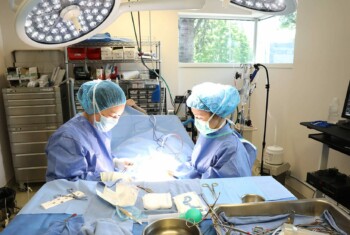Blastomycosis: Presentation, Prognosis and Treatment
Blastomycosis is a common fungal disease found in the central and northern United States, primarily in areas near the Ohio, Missouri and Mississippi River Valleys.
Blastomyces dermatitidis is saprophytic fungus, most often found in moist, acidic soil in endemic areas. The infective mycelial phase is typically inhaled by the host, causing systemic infection. Once within the host at body temperature, the fungus transforms into its yeast form and replicates, causing systemic infection. As the yeast is not aerosolized, the disease is not thought to be transmissible from patient to patient.
Presentation

Lateral thoracic radiograph from patient with disseminated Blastomycosis.
The classic presentation of Blastomycosis is a large breed dog with outdoor access, however the disease can be found in strictly indoor dogs as well as in cats. Animals with close proximity to water or overturned soil (i.e., construction sites) seem to be predisposed to disease.
Commonly affected organs include the respiratory tract, skin, eyes, bones and lymph nodes. Focal skin lesions can develop from a penetrating wound though still should be treated aggressively. Patients often have a harsh cough, fever, malaise and weight loss.
Skin lesions are often also noted, and ocular lesions such as uveitis and chorioretinitis are common. Radiographic findings in the thorax include a diffuse military interstitial pneumonia, focal masses and/or alveolar lung lobe changes.
Bone changes are typically osteolytic and often affect the appendicular skeleton. CBC tends to be consistent with inflammation. Increased globulins and low albumin are frequently found on chemistry panels. Hypercalcemia is seen in some patients.
Diagnosis
The gold standard for diagnosis of Blastomycosis is direct visualization of the organism. The organisms are usually found readily in systemically ill patients. Draining skin lesions should have impression smears performed and lymph node aspirates performed if lymphadenomegaly is present.
Lung aspirates can be pursued though carry a small risk of pneumothorax as a complication. Culture of specimens is not recommended due to risk for lab personnel.
Noninvasive testing is also widely available. The best noninvasive test in detection of Blastomyces organisms is a urine antigen test, which has replaced serum antibody testing. Sensitivity of the urine antigen test is approximately 93.5%. Serology sensitivity varies from 40-90%, and early in the course of disease, the test will be negative.
Treatment
Once Blastomycosis is diagnosed, communication should be thorough with pet owners that this requires long-term commitment to treatment, often needing at least four-to-six months of daily medications.
Itraconazole is the treatment of choice for Blastomycosis. Brand name itraconazole is preferred, though a recent study from the University of Tennessee showed similar pharmacokinetics (though not bioequivalence) with generic itraconazole. Compounded itraconazole should not be used. Patients receiving itraconazole should have liver enzymes and appetite monitored. Vasculitis lesions can also occur in some patients receiving itraconazole, though anecdotally, these seem to resolve with a change to fluconazole.
Fluconazole can also be considered as first-line therapy, though it has a slightly lower efficacy for treatment and required duration of treatment tends to be longer. Amphotericin B can be utilized, though is given intravenously and can be nephrotoxic.
Upon starting antifungal therapy, owners should be warned that respiratory signs and fever can occur due to fungal death. Some patients will need oxygen support within the first week of therapy and if dyspneic, anti-inflammatory steroids are indicated, though these should be discontinued as soon as possible. A urine antigen test should be utilized to monitor response to therapy, with antifungal continued one month past a negative urine antigen test.
Prognosis

Blastomyces budding yeast and associated pyogranulomatous inflammation from a clinical patient with Blastomycosis. Organs are 5-20 um in diameter and characteristically have “broad-based budding”.
Image credit: Kelcey Lee Russell, LVT
Prognosis for survival depends on location of disease and severity of signs at onset of therapy, though overall survival with appropriate treatment is estimated to be about 80%. Severe lung involvement and CNS involvement are both poor prognostic indicators.
Many dogs with severe eye involvement require enucleation, as the eye may not have vision restored and it can be a nidus for persistent infection. Approximately 20% of dogs can relapse after treatment with antifungals.


